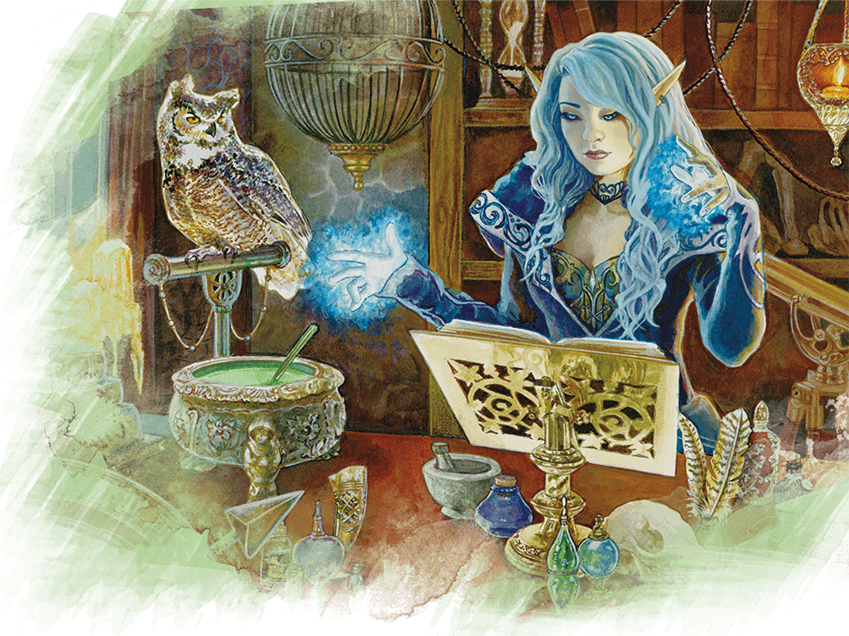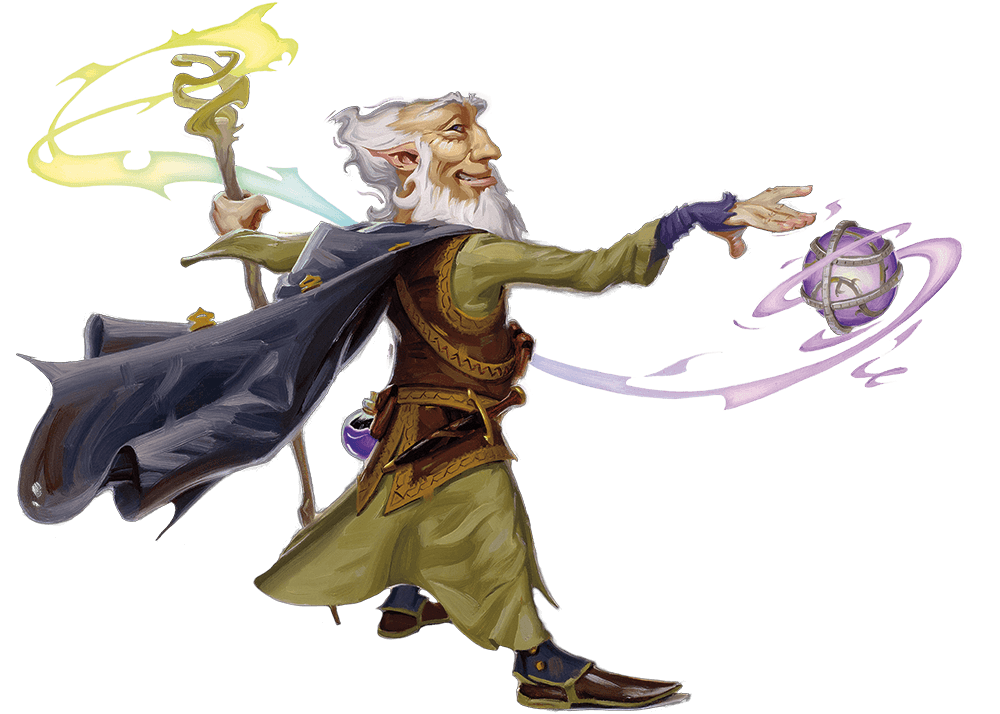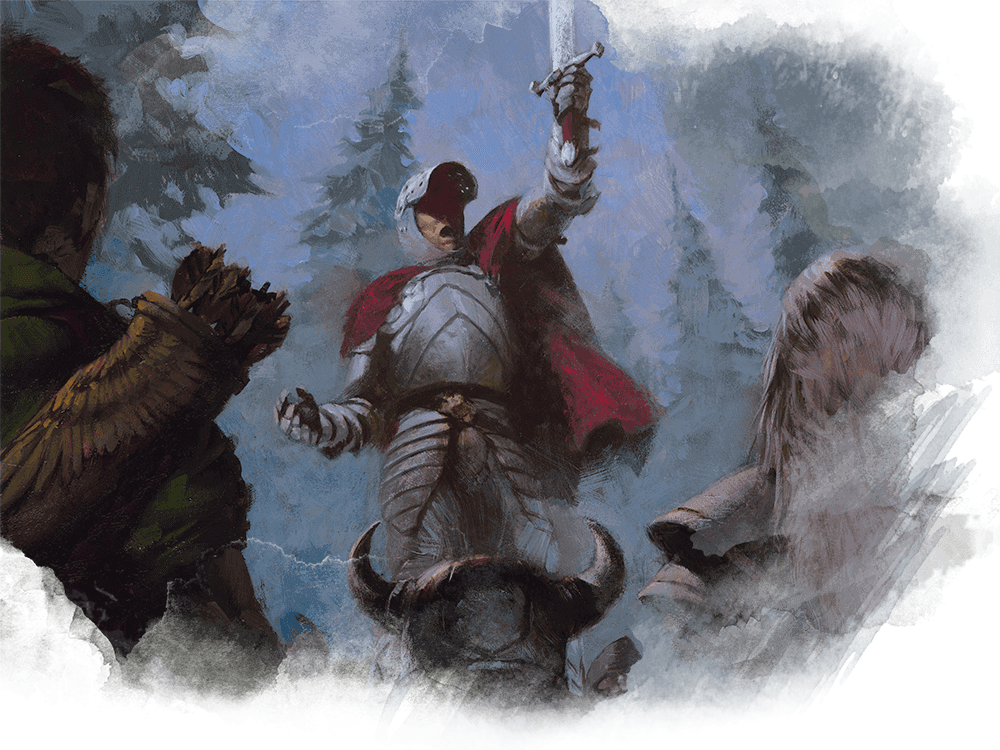Balance is something every Dungeon Master has to contend with when plotting an adventure, and erring on the conservative side with magical items is part of this. After all, the common thought is that D&D can quickly go haywire if low-level characters get their paws on mystical goodies too early.
But wait just a moment, because there’s a line in Chapter 7 of the Dungeon Master’s Guide that seems to suggest otherwise: “If you want a ring of invisibility to fall into the hands of a 1st level character, so be it. No doubt a great story will arise from that event.”
Yep, that’s a reference to The Hobbit, and we all know the tale that emerged after Bilbo Baggins stumbled upon the Ring of Power in the Misty Mountains. This brings me to an intriguing proposition: is it occasionally appropriate to award a low-level player with an unusually powerful item? Obviously, it depends on the group and the type of game you want to run, but I would argue that if the item is tied to the campaign’s story in some fashion, then it certainly is.

A deadly dagger segues into the plot foreshadowing...
Take, for instance, the beginning chapters of Icewind Dale: Rime of the Frostmaiden, where players may find themselves investigating duergar crimes around Ten-Towns. (Light spoilers ahead!) At some point, players may fight a duergar mind master hiding within the Easthaven ferry. My players faced this fellow when they were level 2, and it’s a tough encounter, especially since he can call three goons to assist him and uses multiple attacks with a Mind-Poison Dagger that does 5 (1d4 + 3) piercing damage plus 10 (3d6) psychic damage - enough to KO a second level character with a few hits.
But via a combination of good rolls and smart tactics, my players vanquished this foe, and in the aftermath of the fight, the rogue asked what he could find on the mind master’s corpse. I thought about it for a moment...and then said that the Mind-Poison Dagger was lootable.
I know what you’re thinking - that’s an overpowered weapon for a level 2 character! Even the rogue thought that at first.
“Are you kidding?!” he asked after he learned of the dagger’s capabilities. “Was this some kind of random item chosen on a loot table?”
I said it wasn’t, and as the rest of the party congratulated the rogue on acquiring something above his weight class, I asked him to roll an Insight check.
“It’s a devastating dagger,” I said when he passed the check. “One that’s ornate, intricate, and radiating deadly energy. A weapon fit for someone very, very important and obviously of high status in duergar society.”
The party suddenly quieted down, and you could almost hear the anxiety creeping into their heads. Eventually, the monk asked: “Uhh...so...who did we just kill?”
See, my players hadn’t communicated with the mind master or his men before dispatching them, since they had no command of Undercommon. All they knew was that these thieves had been pilfering items made of chardlyn - a metal infused with demonic energy - and since the perps were now dead, there was nothing to indicate that actually, the mind master was Nildar Sunblight, the son of a duergar warlord who intended to destroy Ten-Towns.
Nothing but the Mind-Poison Dagger, that is. Suddenly, my players became instantly interested in who this important personage was and why he was packing such potent weaponry. While they’d initially viewed the Easthaven ferry mission as nothing more than a side quest, immediately it became their priority to decipher everything they could about this impending duergar conspiracy, which becomes a major focal point in the campaign’s third chapter.
Here was an instance of unorthodox narrative advancement and group investment that occurred from gifting a powerful weapon to a player. And yes, the rogue did make judicious use of his newfound dagger, though as the party leveled up and other characters gained access to nifty toys, his damage output was no longer quite as extraordinary. Balance, in other words, was not completely thrown out of the window simply because a level 2 rogue got his hands on something special. Instead, the plot and dramatic tension of my game increased, because the item was intricately connected with the overarching story.

High-risk items lead to high reward roleplaying...
The Dungeon Master’s Guide is replete with magical items, many of which can wonderfully alter a campaign’s trajectory if placed in the hands of a still-developing character. Or perhaps that character possessing such an item could be the impetus for an entire campaign. Here are some possibilities for both ideas.
- An Amulet of the Planes lets a wearer cast Plane Shift with a successful DC 15 Intelligence check, dragging anyone within 15 feet to a random plane of existence or a familiar location. Such an item could be the basis of a fabulous plane-hopping adventure, perhaps inspired by the Disney short The Sorcerer’s Apprentice, where Mickey steals the hat of his wizard mentor only to wreak havoc with spells he cannot control. Perhaps the players are newbie mages who pilfer the amulet from their teacher, attune to it and travel to places they’ve studied in textbooks - only to wind up stuck in the Feywild after a Quickling steals the amulet from them. The Well of Many Worlds can also be a good item for this concept and might be preferable since it doesn’t require attunement or a skill check.
- Once again, think of The Hobbit, where Bard defeats Smaug with a black arrow - essentially an Arrow of Slaying attuned to killing dragons! Now imagine a campaign where the players are lowly residents of a town under attack by vicious wyrmlings. The entire story could revolve around forging or obtaining Arrows of Slaying to vanquish these winged terrors, and the moment the players deliver their killing blows could serve as the epic finale.
- The Berserker Axe allows for a +1 bonus to attack and damage rolls and increases a player’s hit point maximum by 1 for each level. But it also carries a curse, forcing players to go berserk if they don’t succeed on a DC 15 Wisdom saving throw when attacked. This item would be perfect for Icewind Dale: Rime of the Frostmaiden, particularly during encounters against chardlyn berserkers. Reskin one of these axes to say it’s made of chardlyn, and then have a party member acquire it while infiltrating the berserker base. Let the curse speak for itself, potentially giving a weak player the chance to deal high damage while also gaining insight into the strengths and drawbacks of a demon-touched metal.
- It’s a cliché by now, but why not hand out a Cloak or Ring of Invisibility and let your party live out their hobbit burglar fantasies? Stealing treasure from underneath a powerful dragon’s nose - and then attempting to get out of the creature’s lair alive - could make for one heck of a campaign moment, especially for level 3 adventurers.
- If you ever wanted to pull inspiration from Aladdin, the Efreeti Bottle’s your go-to item. This could be a deadly one for extremely low-level parties since a DM is supposed to roll a d100 to determine what happens the first time the bottle’s opened and rolls from 01 - 10 result in efreeti attacks for 5 rounds. Nevertheless, if you choose to handwave this rule or roll higher than a 10, the efreeti must carry out the whims of the party, even granting them the Wish spell three times on rolls from 91-00. Why not take inspiration from Aladdin’s Cave of Wonders and design a trap-filled treasure trove with the bottle as the final prize, potentially granting penniless players everything they ever wished for? And if they die fighting the efreeti, their descendants can always enter the cave a generation later to avenge them…
- The Horn of Valhalla is a similarly high-risk, high-reward item that can bring warriors from the plane of Ysgard to a player’s aid, though these warriors also might attack if the character doesn’t have the correct weapon and armor proficiencies. A fighter, paladin or similar martial class would probably benefit the most from this item for this reason, and perhaps the horn could be re-flavored to summon deceased warriors slain by the campaign’s big bad. For instance, the Horn of Valhalla would work well in a Curse of Strahd campaign to bring forth old enemies defeated by Barovia’s vampire lord, like knights from the Order of the Silver Dragon. How would a level 2 paladin react to seeing these living legends, now under his control?
- Ever wanted to design a campaign about controlling monsters, a la Pokémon? Check out the various Rings of Elemental Command, which let characters cast Dominate Monster and grant them elemental-specific abilities upon killing the appropriate foe. A party could be tasked with traveling the world, subduing nature spirits that have run amuck and absorbing their essences as per the abilities of each ring, gaining flame spells from fire elementals, and the ability to move through solid rock from earth elementals. Eventually, these powers make the party resemble superheroes, and a campaign that started as Pokémon slowly turns into the X-Men.
- The Dungeon Master’s Guide provides examples of three sentient weapons hidden beneath White Plume Mountain - the sword Blackrazor, which lustfully devours souls, the trident Wave, which longs to create sea god converts, and the warhammer Whelm, which seeks to protect dwarvenkind. Each of these weapons has a distinct personality and could grant tremendous power to a low-level character for a price. If I were to insert these sentient accouterments into a campaign, I’d take inspiration from the 1997 Japanese RPG Tales of Destiny for the Playstation 1 (which featured talking blades called Swordians) and really play up their personalities to create a unique blend of NPC and weapon.
With great power comes...you know.
I’ve only scratched the surface with the above examples, as the Dungeon Master’s Guide contains plenty of unpredictable items like the Deck of Many Things - which as any fan of Critical Role can attest, contains the potential to turn the world topsy turvy in the hands of experienced adventurers, let alone newbies.
Then there are the storytelling possibilities that could erupt from letting seemingly insignificant NPCs get their hands on powerful items. One could use the rules in the upcoming Van Richten’s Guide to Ravenloft, for example, to devise a Domain of Dread ruled by a lowly pageboy who wanted to become a famous knight but wasn’t willing to put in the work until the malevolent blade Blackrazor stumbled into his hands and corrupted his soul.
Let that pageboy be a cautionary tale, because once again - allowing mighty items to fall into the hands of low-level characters is a decision that needs to be made with care. It isn’t a great fit for all groups, particularly ones with players who take pleasure in “breaking the game” and manipulating the mechanics of D&D. But if you’ve got the right crew and suspect that a wondrous magic item can usher in thrilling story developments, go ahead and take a leap of faith. Just be sure to tell your players to remember the words of a famous sage named Uncle Ben...for “with great power, comes great responsibility!”
Jeremy Blum (@PixelGrotto) is a journalist, gaming blogger, comic book aficionado, and fan of all forms of storytelling who rolled his first polyhedral dice while living in Hong Kong in 2017. Since then, he's never looked back and loves roleplaying games for the chance to tell the tales that have been swirling in his head since childhood.
Candlekeep Mysteries and Van Richten's Guide to Ravenloft are available for preorder now in the D&D Beyond Marketplace! All preorders come with digital dice, as well as character themes, frames, and backdrops!









-
View User Profile
-
Send Message
Posted Mar 12, 2021Wow!
-
View User Profile
-
Send Message
Posted Mar 12, 2021Second! Also, great article as usual. I'm giving my 3rd level players a homebrew sentient trident, and this gives a few good reasons for making it more powerful than previously intended. The person wielding it doesn't have proficiency with the trident, so even pretty powerful capabilities would kinda be nerfed in his hands. He's never gonna give it up though. NEVER!
-
View User Profile
-
Send Message
Posted Mar 12, 2021Thanks for this. It gave me some great ideas.
-
View User Profile
-
Send Message
Posted Mar 12, 2021Great article
-
View User Profile
-
Send Message
Posted Mar 12, 2021POWER
-
View User Profile
-
Send Message
Posted Mar 12, 2021What a great premise! As always, I love your examples.
-
View User Profile
-
Send Message
Posted Mar 12, 2021Great article! I have given my group an overpowered magic item before, and found it’s not actually that hard to adjust encounters to correspond with the overpowered magic item.
-
View User Profile
-
Send Message
Posted Mar 12, 2021Thank you! I will say, however, that even though I am a little conservative with magic items, I think going overboard just stops being fun. I'm playing a Dragon of Icespire Peak campaign right now and the DM has given each of us a magic item/creature, as well as one for the entire group - a giant, magical dog named McProngles the 2nd. This has lead me to get deeper into the campaign (who was McProngles the 1st?), but we could probably defeat Cyrovain now (and we're each 3rd level).
-
View User Profile
-
Send Message
Posted Mar 12, 2021I was going to give my party a Cubic Gate, but an Amulet of the Planes is better and more reasonable. I also noticed that an Amulet of the Planes lets you teleport to teleportation circles via the plane shift spell, but it doesn't teach you teleportation circles. This means you can add a "fast travel" option for your characters, so when they get lost in the Demonweb at 3rd level, they can get out of there. Finally, it makes the character with a high intelligence score suddenly have the best ability in the party.
-
View User Profile
-
Send Message
Posted Mar 12, 2021Good article!
-
View User Profile
-
Send Message
Posted Mar 12, 2021For sure, even with adjusting encounter difficulty to compensate for powerful items, it's a delicate balance! I realized this in one of my campaigns where the heroes became way more tricked out than I expected. (They kind of became the mascots of a small town and reunited the owner of a general store with her long-lost father - basically getting potions for free and magic items at heavy discounts as a result.) Then again it's a two-player campaign that my girlfriend's in and serves as her intro to D&D, so letting her and her friend get unusually powerful has been fun to see :)
-
View User Profile
-
Send Message
Posted Mar 12, 2021Once, I decided to give the 1st level PCs an Apparatus of Kwalish(a legendary magic item). They almost immediately figured out what it was (the rogue was a magic item expert), but they never used it. They just hauled it along in their carriage.
-
View User Profile
-
Send Message
Posted Mar 12, 2021Hmm... it fit? How much space did they have left, then?
-
View User Profile
-
Send Message
Posted Mar 12, 2021Portable hole can be an amazing tool in the hands of some creative players... cast cloud of daggers at the bottom of the hole and voila... enemy smoothies.
-
View User Profile
-
Send Message
Posted Mar 12, 2021Thanks for the inspiration!
-
View User Profile
-
Send Message
Posted Mar 12, 2021Best article I've read in while.
-
View User Profile
-
Send Message
Posted Mar 12, 2021Great article!
-
View User Profile
-
Send Message
Posted Mar 12, 2021My Dragon Heist players managed to (perfectly legitimately) steal Azuredge from its owner at level 4. Now the Dwarven Wizard is now wielding it. I'm making them go through some trials before they unlock the axe's full power, but so far it hasn't caused any balance problems... just lots of in-story drama!
-
View User Profile
-
Send Message
Posted Mar 12, 2021Great article! While this isn't a new idea, it's one that doesn't get talked about enough at the developer level, in my opinion, and I think this is a solidly encouraging presentation of it for new GMs, especially.
-
View User Profile
-
Send Message
Posted Mar 12, 2021So good!